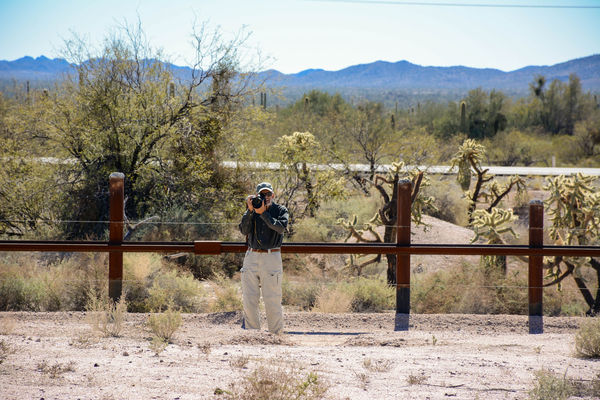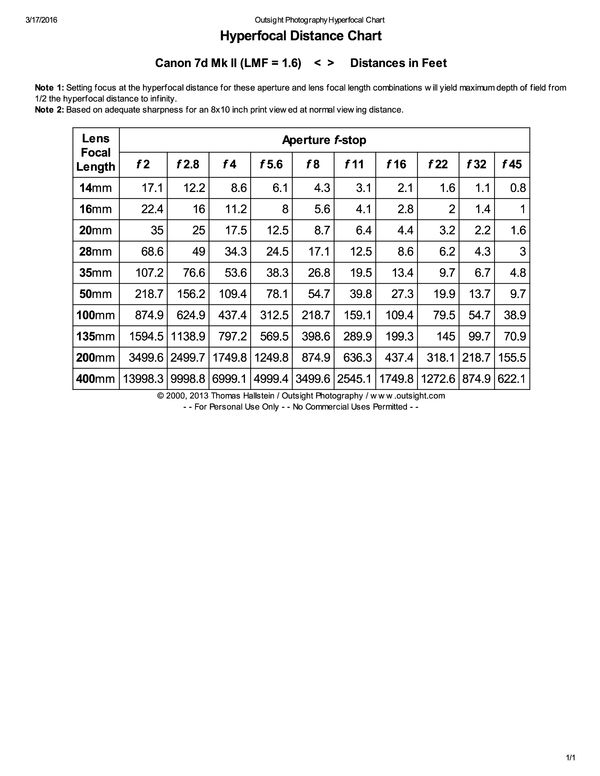Depth of Field question
Mar 23, 2016 14:45:28 #
Nikon D7100, f/8, 1/250, ISO 100, 18-140 @ 140 mm.
My buddy and I were goofing off here, taking photos of each other. He was my subject, and I think he's in clear focus. However, I thought the background would also be sharp, and it isn't even just beyond the fence, to say nothing about the mountains in the distance. I'd estimate he was about 50-60 feet from me and I had the zoom at maximum.
With my bridge camera, I would have shot this at f/7.1 (smallest opening is f/8) and everything would have been in focus. Is that because that camera has a smaller sensor? Do you think that if I had narrowed the Nikon's opening to something in the f/14-16 range I would have captured the mountains as well?
Thanks for looking at this.
BTW... He's standing on the US-Mexico border in Organ Pipe Cactus National Monument. The barrier behind him is the border; it's designed to bar any vehicular traffic from entering the US. The area is so isolated that I guess they figure any illegal foot-crossers will eventually be apprehended, if they don't die in the desert.
My buddy and I were goofing off here, taking photos of each other. He was my subject, and I think he's in clear focus. However, I thought the background would also be sharp, and it isn't even just beyond the fence, to say nothing about the mountains in the distance. I'd estimate he was about 50-60 feet from me and I had the zoom at maximum.
With my bridge camera, I would have shot this at f/7.1 (smallest opening is f/8) and everything would have been in focus. Is that because that camera has a smaller sensor? Do you think that if I had narrowed the Nikon's opening to something in the f/14-16 range I would have captured the mountains as well?
Thanks for looking at this.
BTW... He's standing on the US-Mexico border in Organ Pipe Cactus National Monument. The barrier behind him is the border; it's designed to bar any vehicular traffic from entering the US. The area is so isolated that I guess they figure any illegal foot-crossers will eventually be apprehended, if they don't die in the desert.

Mar 23, 2016 15:05:50 #
According to my DOF calculator on my phone, if your focus was at 50', everything from 44' to 57' would be in focus at f/8, 140mm focal length. I guess that would explain the lack of sharpness. Had you used the same lens at 18mm, sharp focus would have extended from 5.8' to infinity.
Mar 23, 2016 15:36:04 #
DOF is related to 4 items: sensor size (1.5 crop here), distance to subject (50'), focal length of lens (140mm), and aperture (f/8) which results in the 44' to 57' dof that lsimpkins indicated. Even stopping down to f/16 would only get you a dof of 40' to 66'. You would need to set your lens at 70mm and f/16 to get everything beyond the subject in focus. There are many cell phone apps that calculate dof but not all allow for sensor size adjustments - I use F-Stop which includes a parameter for the name of your camera.
Mar 23, 2016 16:08:51 #
ecobin wrote:
I use F-Stop which includes a parameter for the name of your camera.
I use DoF Calc which also lets you specify which camera you are using.
Mar 24, 2016 09:48:06 #
Here is a hyperfocal chart for a Canon APS-C camera at a variety of focal lengths, you can find sites online to create one more appropriate for your lenses and camera. Hyperfocal point defines the focus point where everything from 1/2 the distance to the camera from that point to infinity should be in acceptable focus. The hyperfocal point for a 135mm lens at f/8 for your 150mm would have been at about 400 feet on a Canon camera, or according to this chart had you focused at about 100' at f/32 you would have gotten the results you were looking for.
Mar 24, 2016 13:28:04 #
Blurryeyed wrote:
Here is a hyperfocal chart for a Canon APS-C camer... (show quote)
Would Blurryeyed happen to know the value of the circle of confusion used to construct this table?
Mar 24, 2016 14:02:24 #
The softness of the mountains is due to haze as much as DOF. A smaller aperture wouldn't have made that much difference to the mountains. The mid-field behind the subject is another story.....
With a crop sensor the aperture is subjected to the same reduction factor as the sensor and focal length. If the sensor is 1/2.3, the aperture at f/7.1 is tiny. The reason it's limited to f/8 is because of diffraction.
With a crop sensor the aperture is subjected to the same reduction factor as the sensor and focal length. If the sensor is 1/2.3, the aperture at f/7.1 is tiny. The reason it's limited to f/8 is because of diffraction.
Mar 24, 2016 14:41:58 #
SonoraDick wrote:
Nikon D7100, f/8, 1/250, ISO 100, 18-140 @ 140 mm.... (show quote)
To get a large field in focus you need lots of light, as you did, but you need a small f/stop as in f/16 or so. But that may take a longer exposure so I'd recommend a tripod. Also consider using your camera's 10-second self timer for these shots to avoid camera shake.
Just remember, the wider the f/stop the shorter the DOF.
Oh, you may want to consider bumping your ISO to say 400 for longer exposures. This can also help shorten the time the shutter is actually open.
Good luck. I guess I failed to mention this has nothing what ever to do with the size of your sensor. DOF is strictly a lens issue whether film or digital.
Mar 24, 2016 14:52:08 #
John_F wrote:
Would Blurryeyed happen to know the value of the circle of confusion used to construct this table?
No, but the Calculator allows for the user to calculate for the different senso or film sizes... I assume the creator of the calculator knew what he was doing.
Mar 25, 2016 04:04:24 #
lsimpkins wrote:
According to my DOF calculator on my phone, if your focus was at 50', everything from 44' to 57' would be in focus at f/8, 140mm focal length. I guess that would explain the lack of sharpness. Had you used the same lens at 18mm, sharp focus would have extended from 5.8' to infinity.
Thanks very much for your response. You not only answered my question, but the one I would have asked next as well. 8-) Now I just need to get one of those DOF calculators for my phone... Hope they also have an app to remind me to take it (the phone) with me.
Mar 25, 2016 04:06:38 #
ecobin wrote:
DOF is related to 4 items: sensor size (1.5 crop h... (show quote)
Thanks for the response, and I'll check out F-Stop.
Mar 25, 2016 04:11:48 #
R.G. wrote:
The softness of the mountains is due to haze as much as DOF. A smaller aperture wouldn't have made that much difference to the mountains. The mid-field behind the subject is another story.....
With a crop sensor the aperture is subjected to the same reduction factor as the sensor and focal length. If the sensor is 1/2.3, the aperture at f/7.1 is tiny. The reason it's limited to f/8 is because of diffraction.
With a crop sensor the aperture is subjected to the same reduction factor as the sensor and focal length. If the sensor is 1/2.3, the aperture at f/7.1 is tiny. The reason it's limited to f/8 is because of diffraction.
I didn't think of the haze factor. In Arizona, we usually blame that on California. Maybe in this case, we need to chalk it up to miles and miles of desert, and the winds that are usually present.
Thanks for your response, R.G.
Mar 25, 2016 04:15:04 #
jimmya wrote:
To get a large field in focus you need lots of lig... (show quote)
Thanks for the answer, and especially the ISO suggestion. I wouldn't have ever thought of that in such bright conditions, but it makes sense.
Mar 25, 2016 04:22:24 #
Blurryeyed wrote:
Here is a hyperfocal chart for a Canon APS-C camer... (show quote)
Thanks, Blurryeyed... But I have to admit that without your explanation, I would have been hopelessly lost. (With it, I should be able to find my way back in a couple of days.)
Mar 26, 2016 14:38:11 #
SonoraDick wrote:
Nikon D7100, f/8, 1/250, ISO 100, 18-140 @ 140 mm.... (show quote)
I like the shallow depth of field, since the background is not as important as the subject. Using the extremes of any lens will not be as sharp. Backgrounds at a distance tend to get hazy. I would suggest that if you want a sharp background to close down your aperture. I would also suggest that a single subject would be more pleasing to the eye if shot in portraiture (vertical).
If you want to reply, then register here. Registration is free and your account is created instantly, so you can post right away.








